2007 VOLKSWAGEN JETTA Belt
[x] Cancel search: BeltPage 197 of 477
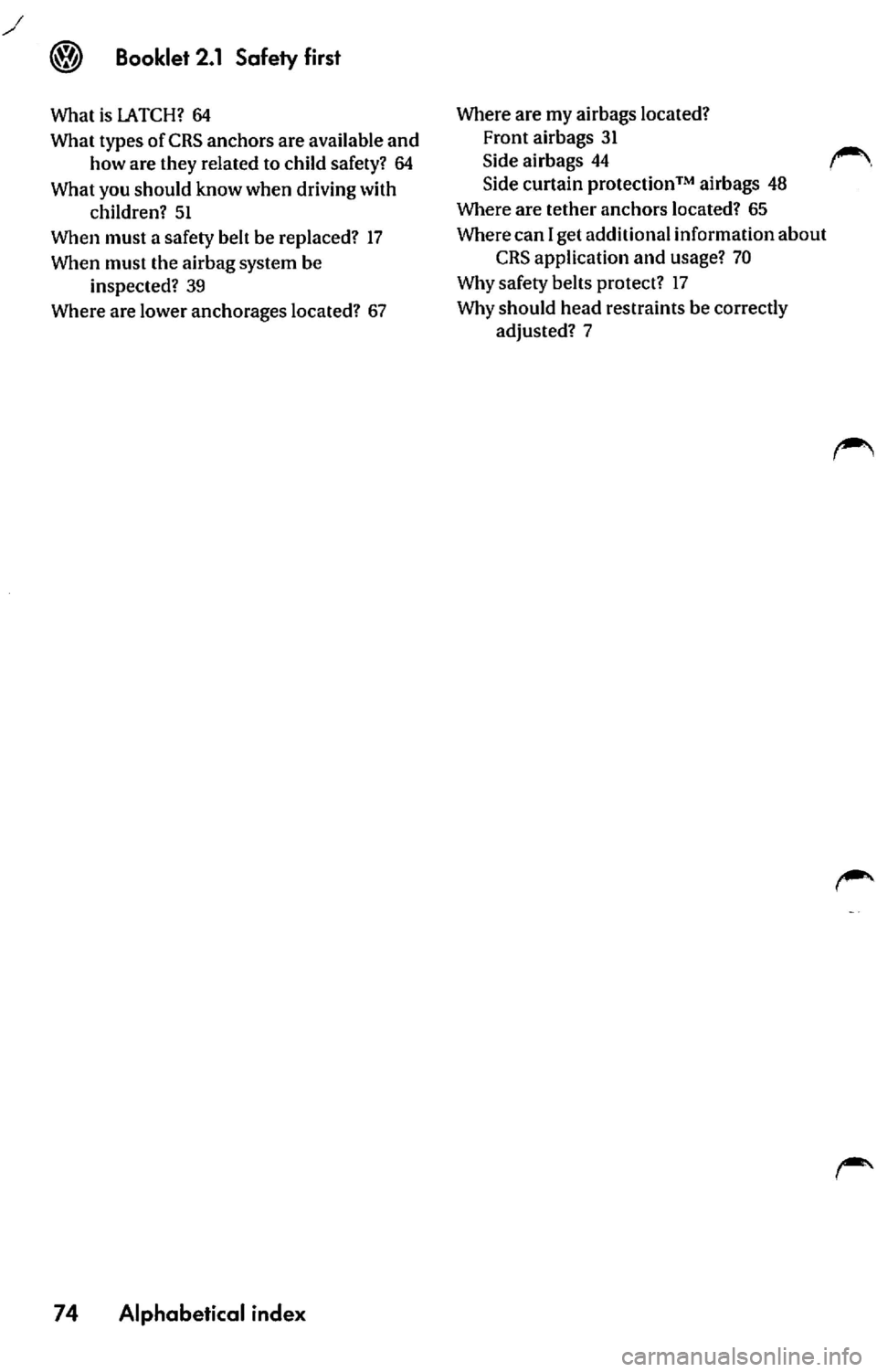
64
What types of CRS anchors are available and how are they related to child safety? 64
What you should know when driving with children? 51
When must a safety belt be replaced? 17 When must the airbag system be inspected? 39
Where are lower anchorages located? 67
74 Alphabetical index
Where are my airbags located? Front airbags 31
Side airbags 44 Side curtain protection
TM airbags 48
Where are tether anchors located? 65
Where can I get additional information about CRS application and usage? 70
Why safety belts protect? 17
Why should head restraints be correctly adjusted? 7
Page 217 of 477

Booklet 3.1 Controls and Equipment
Function
In di splay
5 mi /h (-10 km/h)
Bock Dec reases t he se t va lue by 5 mph (10 km /h }.
Th e
Winter tires men u is close d and th e las t d is pla yed menu is
o pene d.
Tips
The m en us s ho wn in t he di spl ay dep end s on th e
veh icle elec tronic s an d th e o ption leve l of your
App lies lo ve hicles: wi th H igh line i nstr u ment cluster
ve hi cle. If you a re not s ure, as k yo ur authori zed
Vo lkswage n dea ler for as sis ta nce.
Example of using the menus with the windshield wiper lever
All menus in the cluste r can be used following the steps described here.
Fig . 11 In the wind shield wiper lever: button select and expand the menu and roc ker switch© to
select a su b m enu with in the men u
The se tting ofa sp eed warnin g will be used
as an examp le of how to use the menu s.
T he s pee d wa rnin g fe atu re is a help ful re
mind er if yo u are, for exa mpl e, u sin g
w int er tires w hich are not suit ed for the top
spee d
the ve hicl e.
1. Opening the main menu
Switch on the ig ni tion. A vehicle p icto
g ram is di spl aye d.
Press button 11 und er th e
w in ds hield wiper leve r o nce for abou t 5
seco nds and re lease . The followin g me s
sage appears: Plea se fasten seatbelt!
14 Instrument panel
Press an d hold the ro cke r sw itch © for
five seco nds to access the m ain men u. Yo u
ma y have to repeat this pro cedur e severa l
t im es if you had pr eviously se lec ted a dif
ferent me nu until you access the main
m enu.
2. Opening the Set up menu
Press the rocker switch the bottom
to sc roll dow n to Set up. The menu will ap
p ea r betwee n two hori zon ta l lin es and a
m arker tr ia n gle w ill app ear on the right
s id e.
Mark the m en u opt io n Set up .
Press under the w indshi eld
w ip er leve r. Th e m enu Setting s is opened.
3. Opening the Winter tires menu
Pr ess the ro cke r swi tc h © to m ark the
m enu opti on Wint er ti res.
Pre ss to o pen th e sub-m enu
Winter tir es.
4. Setting the speed warning
U se the ro cker sw itch © to mark the
m enu ent ry + 5 mi/h ((+ 10 km /h) ) or -
5 mi/h ((- 10 km /h) ) a nd press the button
to eith er in crease or de crease the spe ed
s h ow n in th e di sp lay above.
Page 260 of 477
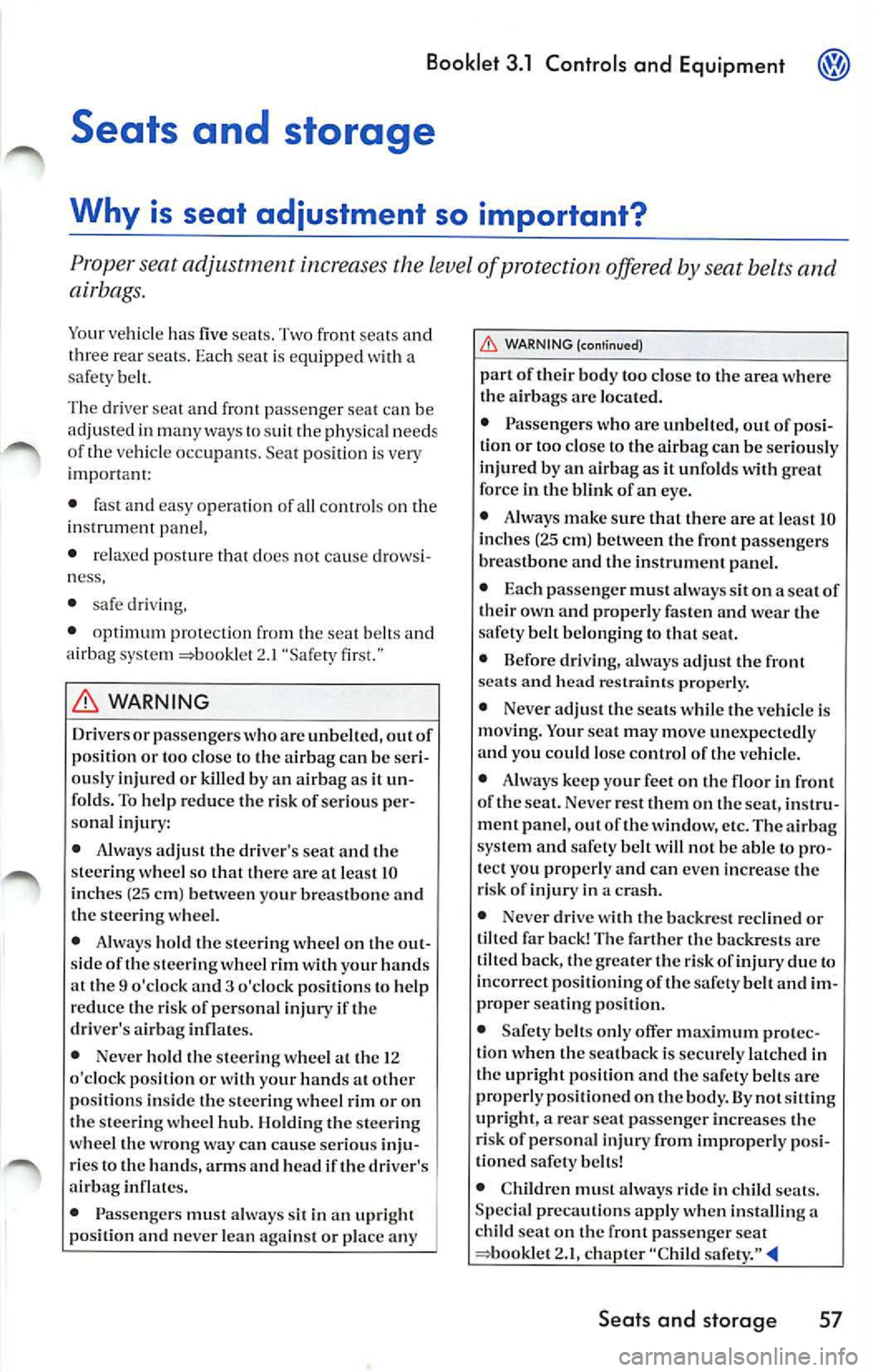
Booklet 3.1 Controls and Equipment
a
safety belt.
Th e dri ver sea t and front pa ssenger seat can be
adjusted in many ways to sui t the physi cal need s
of the ve hicle occupams . Seat position i s very
i mporta nt:
• fast and easy operation of all control s on th e
in strum ent panel,
• relax ed posture that does not ca use drow si
ness,
• safe driving,
• opt imum protection from the seat belts and
airbag syste m
2.1 "Safety fir st."
WARNING
Drivers or passe ngers who arc unbelted , out of
position or too close to the airbag can be seri
ously injured or killed by an airba g as it un
folds. To help reduce the risk of ser iou s per
so nal injur y:
• Alwa ys adjust the driver's seat and the
s teering wheel so that th ere a re at least 10
inches (25 cm) betwe en yo ur breastbone and
the steeri ng w heel.
• Alwa ys hold th e steer ing wheel on th e out
s id e of the s teer ing wheel rim with your hand s
at the 9 o'clock and 3 o'clock positions to help
reduce the risk of personal injury if the
driver 's airbag inflates.
• Neve r hold th e steer ing wheel at the 12
o'clock position or with your hands at other
pos ition s in sid e the steer ing w hee l rim or on
the steer ing wheel hub. Holding the ste ering
w hee l th e wrong way can cause serio us inju
ries to the h ands, ar ms and head if the driver's
airbag inflates.
• P assengers must alway s sit in an upright
po sitio n and ne ver lean against or place any ,0.
WARNING
(continued)
part of th eir body too close to the area where
the airbags arc located.
• Passengers who are unbelt ed, out of posi
tion or too close to the airbag can be seriously
injured by an
as it unfo lds with great
force in the blink of an eye.
• Always make sure th at there arc at least 10
in ch es (25 cm) between the front passeng ers
breastbone and the instrum ent panel.
• Each passenger must always sit on a sca t of
th eir ow n and properly fasten and wear the
safety belt belonging to that seat.
• Before driving, a lways adjust the front
seats an d head restra ints pr operl y.
• Neve r adjust the seats while the vehicle is
moving. Your scat may mo ve unexpectedl y
and you could lose control of the vehicle .
• Always keep your feet on the floor in front
of the scat. Neve r rest them on the seat, instru
m ent panel, out of the window, etc. The airbag
s ystem and safety belt will not be able to pro
t ect you properl y a nd can even increase the
ri sk of injur y in a crash.
• Never drive with the backrest recl ined or
tilt ed far back! The farther the backrests arc
tilt ed back, the greater the risk
due to
in cor rect positionin g of the safety belt and im
proper seating position.
• Safety belts only offer max imum protec
ti on wh en th e sea t back is sec urely latched in
th e upri ght position and the safety belts arc
proper ly positioned on the bod y. By not sitting
upright, a rear scat passenger increase s th e
r is k of per sonal injury from improperly pos i
ti oned safet y belts!
• Children must always ride in child seats.
Specia l precautions apply when insta lling a
child scat on the front pas senger sea t
2.1, ch ap ter "Chi ld
Seats and storag e 57
Page 261 of 477
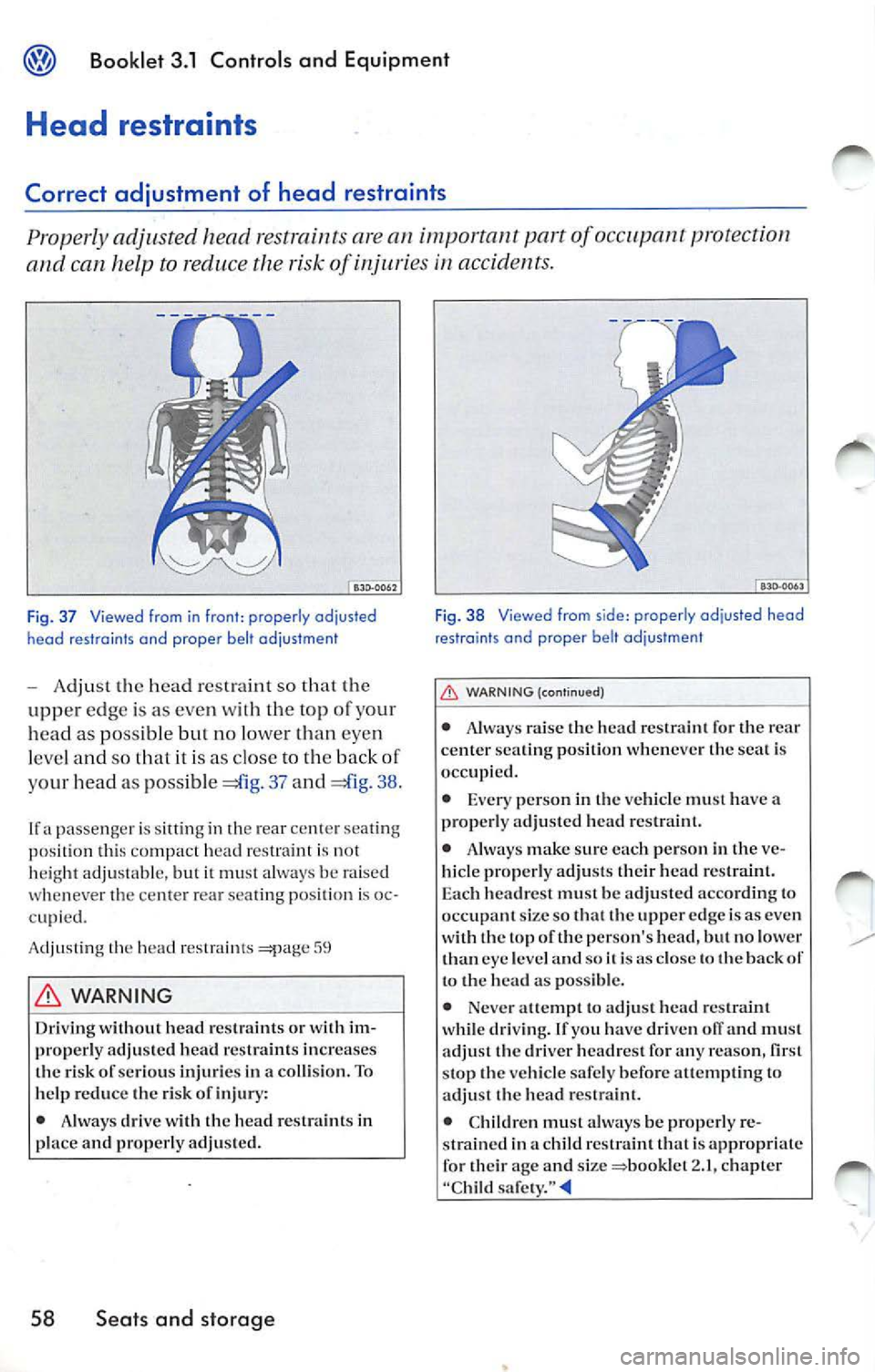
Booklet 3.1 Controls and Equipm ent
Head restraints
Correct adjustment of head restraints
Properly adjusted h ead restraints are an importa 11t part of occupant protection
and can help to reduce the risk of
in accidents.
Fig. 3 7 Viewed from in front : properly odjusted
heod restraints end proper belt odjustment
- Adjust the head restraint so that the
uppe r edg e is as eve n wit h th e top o f your
head as possible
no lo wer than eyen
l eve l and so th at it is as close to th e bac k of
y our head a s possi ble
37 and 38.
If a passenger is s itting in th e rear center sea tin g
position thi s co mpact h ead r estraint is no t
h eight adju stabl e, but it must always be raised
whenever the ce nte r rear sea ting posi tion is oc
c upi ed.
A dju sting the head
WARNING
Driving without head rest raints o r wit h im
prop erly adjusted head restraints inc reases
th e risk of serious injurie s in a co llision. To
h elp reduc e th e risk of injury:
• Always drive with th e head restraints in
place a nd properly adjuste d.
58 Seats and storage
F ig . 38 Viewed from s ide: properly adjusted head
restraints and proper belt ad justment
WARNING (contin ued)
• Always raise the head restrai nt for the r ear
center seating position wheneve r the seat is
occupied.
• Ever y perso n in th e ve hicle must have a
properl y adjuste d head r estra int.
• Alway s make sur e eac h person in the ve
hicle properly adju sts their head restraint.
E ac h headres t must be adjusted a ccord ing to
occupant size s o that the upper ed ge is as eve n
wit h the to p of the person's head, but no lower
tha n eye leve l an d soi
is as clo se th e back to the head as pos sibl e.
• Neve r attempt to adj ust head r estraint
wh ile dri vin g. If yo u have driven
and mu st
adjust the driver h eadrest for any reason,
stop the ve hicle safe ly befo re atte mptin g to
ad just the head r estra int.
• Children must always be properly re
s trained in a ch ild restrain t that i s appropr iate
for their age and size
2. 1, ch apter
"Chil d safety. "
Page 263 of 477
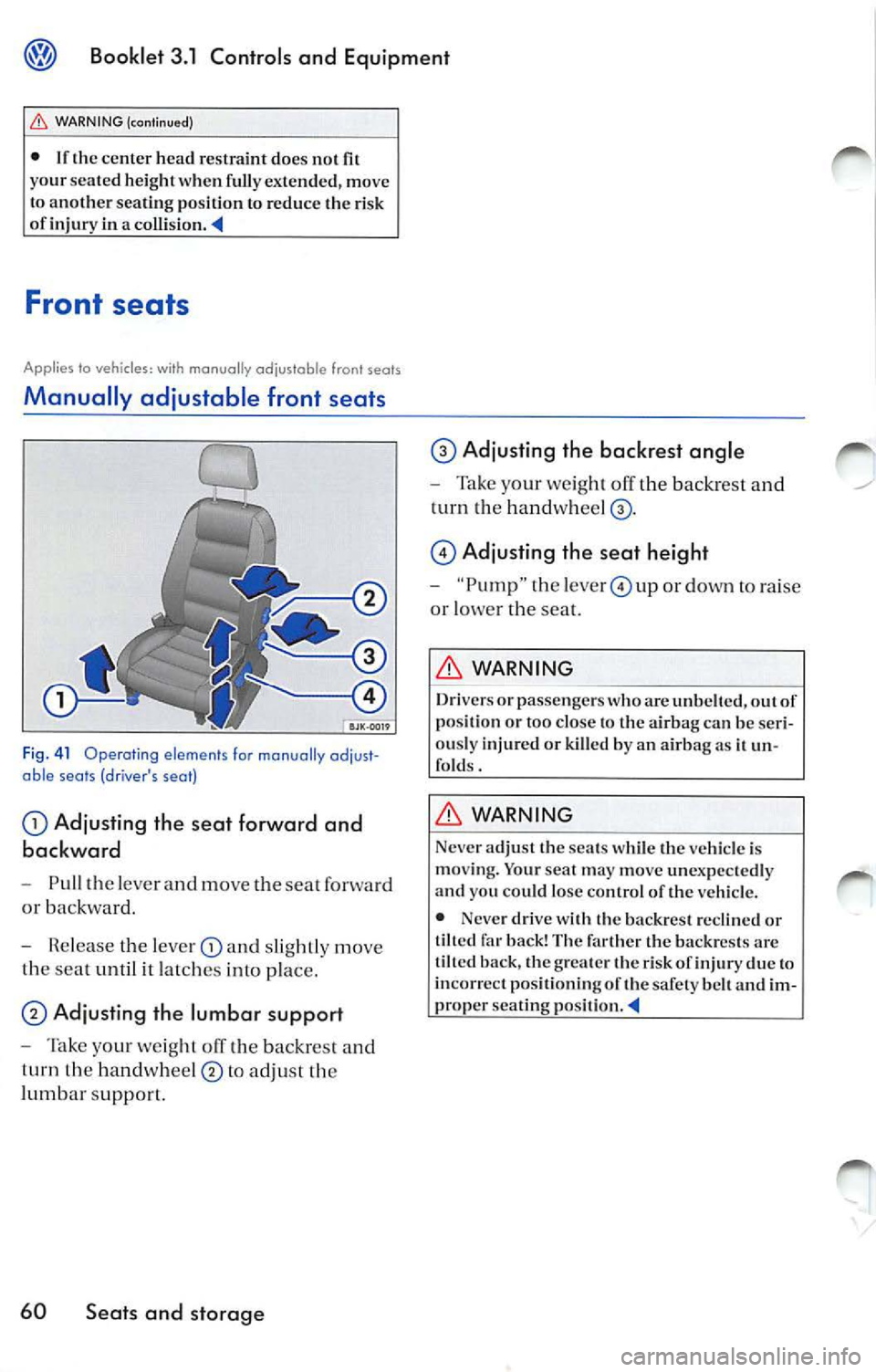
Booklet 3.1 Controls and Equipment
WARNING (continued)
• If th e center head restraint does not your sea te d hei ght when fully extended, move
t o ano ther seati ng po sition to redu ce the risk
of injury in a collision
Adjusting the seat forward and
backward
- Pu ll the leve r an d m ove th e sea t for ward
or ba ckw ard .
He le ase t he le ve r and sli ght ly m ove
t h e se at until it la tc h es into pla c e .
Adjusting the lumbar support
Take y our weig ht off the bac kre st and
turn th e handwh eel
to ad just th e
lu mba r su pport.
60 Seats and storage
Adjusting the backrest angle
Take your weigh t off the b ackres t and
turn the handwh eel
Adjusting the seat height
"Pump " th e or do wn to rai se
or lowe r th e sea t.
Drivers or passenger s w ho are unbelted , out of
position or too clo se to the airbag ca n be ser i
o usly i njur ed or kil led b y an airb ag as it un
fo ld s .
WARNING
N ever adjust the sea ts whi le the vehicl e is
m ovin g. Yo ur seat may mo ve une xpe cted ly
and you cou ld lose co ntrol o f the ve hicle.
• Never drive with the backre st reclined or
lilted far back! The farther the ba ckr ests are
tilted back, the g reat er the risk of injur y due to
in corr ect po siti on in g of the safet y belt and im
prop er seatin g po siti on
Page 265 of 477

Booklet 3.1 Controls and Equipment
Applies to w ith elect rically odjus toble front seals
Electrically ad justable driver and front passenger seats (power seats)
The switches look like a seat viewed from the s ide. The seat cushion and back rest
follow the mot ions of the respective switches.
Fi g. 43 Contro ls for elec tric seal adjustment
Move the co rres ponding switch =£lg . 43
to ad just the fronr seat to suit your size
Adjust ing th e height and for
wa rd/ba ckward position of sea t
c u shi on . . . . . . . . . . . . . . . . . . . . . . . . 63
Adjusting backre st angle . . . . . . . . . 63
Adjusting lumbar support. The cu r
vatu re of the cu shi oned a re a is de
term in ed b y th e se tting s made in
the lum bar region. This supports
the natu ral c ur vature of the sp ine
very effe ctive ly .......... ...... .
WARNING
63
Dri vers or pa ssenge rs w ho are unb elted , out of
p os ition or t oo close to the airbag can b e se ri
o usly injur ed or killed b y an airbag as it un
in "W hy is sca t adju stm ent so im
po rtant? " on page 57.
62 Seats and storage
WARNING
Neve r adjust the seats while the vehicl e is
m oving. You r sea t ma y mo ve un expecte dly
and you could lose control of th e ve hicle.
• Never drive with the ba ckrest r eclined or
tilt ed far back! T he farther the bac kre sts arc
t ilt ed ba ck , the grea te r the ri sk of inju ry due to
incorrec t po sitionin g of the sa fety belt and im
proper seating po sitio n.
• The scats in your vehicle can be electri cally
ad juste d eve n with the ig nit ion ke y removed.
Neve r leave unattend ed childr en in th e ve
hi cle becau se the unsupe rvised use of the
electric scat adju stm ent s ca n result in serious
p erso nal injury.
Page 267 of 477

Booklet 3.1 Controls and Equipment
WARNING
• Never adjust the driver or front passenger
seat while the vehicle is in motion. While ad
ju stin g your seat, you could adjust your seat to
an incorrect sitting position. Adjust your seat
before driving
or when th e vehicle is not
moving.
• The elect rical front seat adju stment also
work s with the ignition off. Therefore, chil
dren sh ould never be lef t unattended in the
vehicle -ther e is a risk of injury!
• Exercise caut ion when adjustin g the seat
height or fonvard/backward position. Care
l ess use of the front seat adjustment co ntrols
can cause injuri es.
WARNING (continued)
• To reduce the risk of personal injury in an
accident, front seat passenge rs must never
ride in a moving vehicle w ith the seat back re
clined. Safet y belt s offer prote ction only when
th e seatback is upright and belt s are properl y
po sition ed on the bod y. The more Lheseatback
i s re clined, the greate r th e risk of personal in
ju ry from an out of position safety belt.
avoid damaging the e lec trical co mp onen ts of
th e front seat, do not knee l on the sea t or apply
dir ect pressure at a sing le po int to the seat
cu shi on a nd
Applies to vehicles: wilh electrically adjustable fronts seat and memory buttons
Memory for driver 's s eat
Use memory buttons on dri ver seat to sto re to three diffe rent positions
for
seat.
••••
F ig. 46 Memory buttons on the front seot: to sove
the setlings, first press the SET butlon and then one
of the memory butlons , l, 2 or 3 .
Storing settings for driving forward
-Sw itch on the igniti on. Do not en gage
Rever se gear.
64 Seats and storage
-Press the =*i g. 46
bri efly whil e the key is s till in the ignition .
T hi s ca n be don e on the driver side only
whe n th e ve hicle is
moving.
- lfyou w ish to reca ll the memor y set
t ings whe n the vehicle is moving, hold
dow n the memory button until the sa ve d
p osit ion is reac hed .
The m em ory butt ons ca n sto re th e sea t positions th e fron t d river
Page 270 of 477
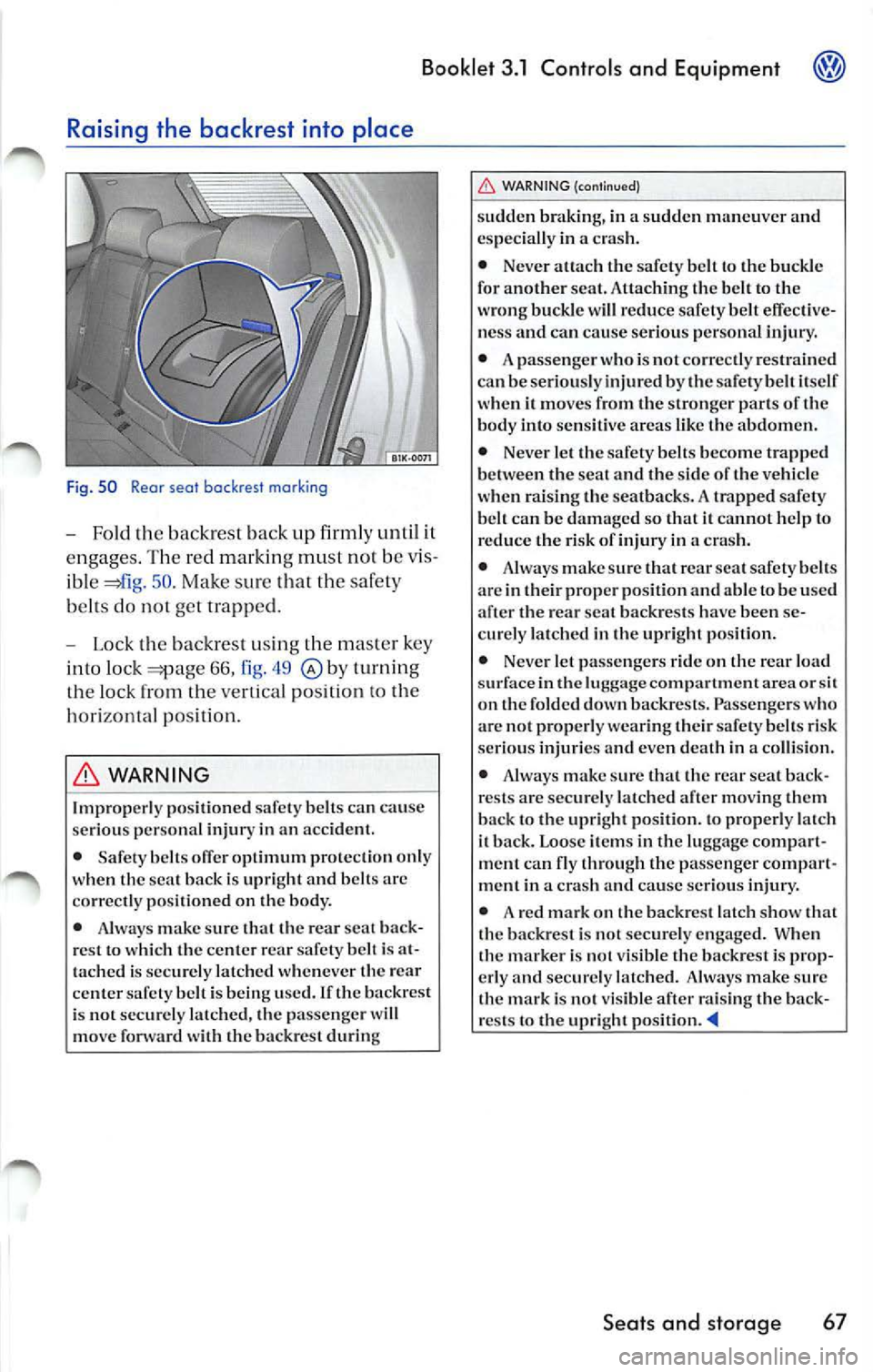
Booklet 3.1 Controls and Equipment
Raising the backrest into place
Fig. 5 0 Rear seat backrest marking
-Fold the backrest back up firmly until it
engages. The red marking must not be vis
ibl e
50. Make sure that the saf ety
bel ts do not get trapped.
- Lock the backrest using the master key
into lock
66, fig. 49 by turning
th e lock from the vertical position to the
horizonta l po sition.
WARNING
Improperl y positioned safety belts can ca use
serio us personal injury in an accident.
• Safety belts olTeroptimum protection only
w hen the scat back is upright and belts arc
correc tly positioned on the body.
• Always make sure that the rear scat back
rest to which the center rear safety belt is at
t ached is secure ly lat ch ed whenever the rear
center safe ty belt is being use d. If the backre st
is not secure ly lat ch ed, the passenger
will move forward with the backrest during
WARNING (continued)
sudde n braking, in a sudden maneuver and
es pecia lly in a cras h.
• Never attach the safety belt to the buckle
for another seat. Attac hing the belt to the
wrong buckle
will reduce safety belt effective
n ess and can cause serious persona l injury.
• A passen ger who is not correc tly re strain ed
can be ser ious ly injured by the safety belt itself
when it move s from the stronger parts of the
bod y into sensitiv e areas like th e abdomen.
• Never le t the safety belts become trapped
between the scat and the side of the ve hicle
when raising the scat back s. A trapped safety
belt can be damag ed so that it can not help to
r ed uce the risk of injury in a cras h.
• Alway s mak e sure that rear seal safe ty belts
arc in their proper positio n and able lo be used
after the rear scat backr ests have been se
c ur ely lat che d in the up right position.
• Neve r let passengers ride on the rear load
surface in the luggage compartment area or sit
on the folded clown backrests. Passengers who
are not properly wearing their safety belts risk
ser ious injuri es and even dea th in a co llisio n.
• Alwa ys make sure that the rear seat back
r es ts are securely latched after moving them
back to the upright positio n. to properly latch
it back. Loose items in the
compart
ment can fl y through th e passenger compart
ment in a crash and cause ser ious injury.
• A red mark on the backre st latch show that
the back rest is not secur ely engaged. When
th e marker i s not visible th e backrest is prop
erly and securely latched. Always make sur e
the mark i s not visi bl e after raising the back
re sts to the upri ght
Seats and storage 67